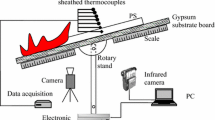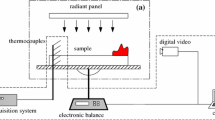Abstract
Rigid polyurethane (PUR) foam, a sustainable thermosetting building facade porous polymer material, has been widely applied in the construction industry for energy conservation. Additional knowledge of the fire safety performance of PUR foam at different altitudes and sample widths is required. Comparative lab-scale experiments were conducted in the Lhasa plateau (66.5 kPa) and the Hefei plain (99.8 kPa) in China. Flame propagation characteristics (average flame spread rate and flame height) were measured at different widths and atmospheric pressures of the test locations. Experimental results show that the dependence of dimensionless flame heights on sample width shows negative power law relationships with index of -w / 5.4 - -w / 5.8. Both flame height and flame spread rate were lower under low ambient pressure conditions as Hf ∝ P0.26~0.33 and Vf ∝ P0.057~0.568 Flame spread rate decreased with increasing sample width in the convection regime before a critical width of 4 cm – 8 cm, after which the flame spread rate increased in the radiation regime. Results of this study contribute to the science of combustion, fire safety and energy conservation, and provide a basis for fire safety protocols for historical heritage buildings in the Lhasa plateau.
Similar content being viewed by others
References
Grenfell Tower fire. https://en.wikipedia.org/wiki/Grenfell_Tower_fire, 2017 (accessed on Dec 01, 2017).
Zhou Y.. Experimental investigation on downward flame spread over rigid polyurethane and extruded polystyrene foams. Experimental Thermal and Fluid Science, 2018, 92: 346–352.
Jiang X., Fan W.C.. Numerical simulation of microgravity flame spread over solid combustibles. Journal of Thermal Science, 1995, 4(2): 141–149.
Ma X., Tu R., Fang T.Y.. Thermal and fire risk analysis of low pressure on building energy conservation material flexible polyurethane with various inclined facade constructions. Construction and Building Materials, 2018, 167: 449–456.
Ma X., Tu R., Xie Q.Y.. Experimental study on the burning behaviors of three typical thermoplastic materials liquid pool fire with different mass feeding rates. Journal of Thermal Analysis and Calorimetry, 2016, 123(1): 329–337.
Ma X., Tu R., Ding C., Zeng Y., Xu L., Fang T.Y.. Experimental study on thermal safety analysis of flexible polyurethane at various facade inclined structures under low ambient pressure condition. Engineering Structure, 2018, 176: 11–19.
Ma X., Tu R., Zeng Y., Fang T.Y., An analysis of low ambient pressure on fire risks associated with rigid polyurethane building facade insulation under various width constructions. Indoor and Building Environment. DOI: 10.1177/1420326X18798003.
Ma X., Tu R., Xie Q.Y.. Study on downward flame spread behavior of flexible polyurethane board in external heat flux. Journal of Thermoplastic Composite Materials, 2015, 28 (12): 1693–1707.
An W.G., Thermal and fire risk analysis of typical insulation material in a high elevation area: Influence of sidewalls, dimension and pressure. Energy Conversion and Management. 2014, 88: 516–524.
Tu R., Zeng Y., Fang J., Zhang Y.M.. The influence of low air pressure on horizontal flame spread over flexible polyurethane foam and correlative smoke productions. Apply Thermal Engineering, 2016, 94: 133–140.
Li J., Zhang Y.. Characteristics of flame spread over the surface of charring solid combustibles at high altitude. Chinese Science Bulletin, 2009, 54: 1957–1961.
He B.J., Yang L.. Strategies for creating good wind environment around Chinese residences. Sustainable Cities and Society, 2014, 10: 174–183.
Mou B., He B.J., Zhao D.X.. Numerical simulation of the effects of building dimensional variation on wind pressure distribution. Engineering Applications of Computational Fluid Mechanics, 2017, 11(1): 293–309.
Kleinhenz J., Hsu S.. Pressure modeling of upward flame spread and burning rates over solids in partial gravity. Combustion and Flame, 2008, 154: 637–643.
Jiang L.. Sample width and thickness effects on upward flame spread over PMMA surface. Journal of Hazard Materials, 2018, 342: 114–120.
Zukoski E.. Entrainment in fire plumes. Fire Safety Journal, 1983, 3: 107–114.
Fang J., Yu C.Y., Tu R.. The influence of low atmospheric pressure on carbon monoxide of n-heptane pool fires. Journal of Hazard Materials, 2008, 154: 476–483.
Gong J.H.. Influences of low atmospheric pressure on downward flame spread over thick PMMA slabs at different altitudes. Journal of Heat and Mass Transfer, 2013, 61: 191–200.
Gong J.H.. Effect of finite dimension on downward flame spread over PMMA slabs: Experimental and theoretical study. Journal of Heat and Mass Transfer, 2015, 91: 225–234.
Yan W.G., Shen Y., An W.G., et al.. Experimental study on the width and pressure effect on the horizontal flame spread of insulation material. International Journal of Thermal Sciences, 2017, 114: 114–122.
Acknowledgements
This work was supported by the National Key Research and Development Program of China (No. 2017YFC0803300), the National Natural Science Foundation of China (No. 51506059 & No. 51478002 & No. 51606002), the Natural Science Foundation of Anhui Province, the science and technology major projects of Anhui province (No. 16030801118), the Natural Science major research projects of Anhui Education Department (No. KJ2016SD14), and the Educational Commission of Anhui Province of China (KJ2017A499). The authors gratefully acknowledge all these supports.
Author information
Authors and Affiliations
Corresponding authors
Rights and permissions
About this article
Cite this article
Ma, X., Tu, R., Cheng, X. et al. Sub-Atmospheric Pressure Coupled with Width Effect on Downward Flame Spread over Energy Conservation Material Polyurethane Foam. J. Therm. Sci. 29, 115–121 (2020). https://doi.org/10.1007/s11630-019-1077-9
Received:
Published:
Issue Date:
DOI: https://doi.org/10.1007/s11630-019-1077-9




